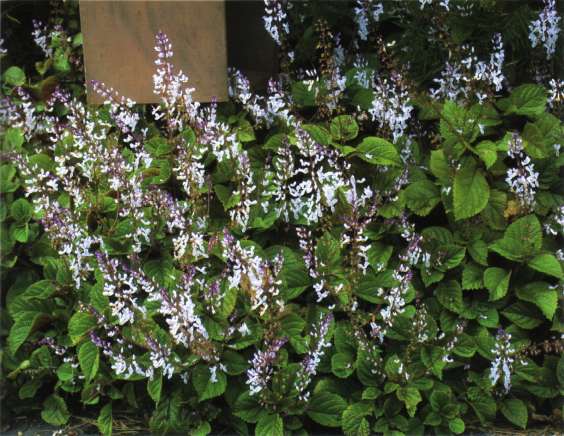|
 An
Illustrated Guide to An
Illustrated Guide to
Common Weeds
of New Zealand
Plectranthus
ciliatus
plectranthus
Family
LAMIACEAE
Reproduced from
Common
Weeds of New Zealand
by Ian Popay, Paul Champion & Trevor James
ISBN 0 473 09760 5
by kind permission of the
New
Zealand Plant Protection Society
Publication or other use of images or descriptive
text on these pages is unauthorised unless written permission is
obtained from the authors and publisher.
Appropriate acknowledgement
of the publication Common Weeds of New Zealand must always
be given.
Available from Nationwide Book Distributors
Trailing or straggling
herb or shrub, with shining leaves, purple underneath. Flowers white,
with purple dots inside the lower lip. Spreads vegetatively by runners.
Commonly grown in houses and gardens.
- Flowers Inflorescence
raceme-like, up to 30 cm long, sometimes with short branches near
the base. Corolla tube white, about 1 cm long, with two-lobed
upper lip and purple dots inside the lower lip. Flowers Dec-Aug.
- Fruit Dark
brown nutlets about 1.5 mm in diameter.
- Leaves In
opposite pairs, shining, purple underneath, dotted with glands,
hairy especially on veins, 5-12 cm long by 3.5-7 cm wide. Leaf
stalks 20-35 mm long.
- Stems Trailing
or straggling, covered in purple hairs.
- Roots Spreads
vegetatively by runners.
Habitat
Shady areas in and
around forest margins, plantations and hedges.
Distribution
Locally abundant in
NI. In SI, only found around Karamea (Buller). Originally from
eastern South Africa.
Comments
Originally introduced
as a trailing pot plant, and still widely grown in gardens and
houses. Listed on the National Pest
Plant Accord (see Introduction for details).
Related
and similar species
A close relative of
plectranthus, Plectranthus ecklonii (blue spur flower),
is widely grown in NZ, but is rarely found growing wild. It is
also subject to Pest Plant Management Strategies in several regions
of NZ. Details are available from individual regional councils
or unitary authorities. Wood sage (Teucrium scorodonia)
is another hairy, rhizomatous labiate found on forest margins,
scrub and plantations, lacking purple-coloured foliage, flowers
green with purple stamens on a terminal spike, scattered throughout,
only common in northern SI.
Derivation
of botanical name
Plectranthus (Gk.)
= spurred flower; ciliatus (Lat.) = hairy.
Web-notes:
Weed Links
On this site
Reproduced from Common Weeds
of New Zealand:
External Links
 Weedbusters
New Zealand Weedbusters
New Zealand
- Weedbusters is a weeds awareness and education programme that aims to
protect New Zealand's environment from the increasing weed problem.
- AgPest
- A free tool to assist farmers and agricultural professionals in decision-making regarding weed and pest identification, biology, impact and management.
 New Zealand Weeds Key New Zealand Weeds Key
- An interactive identification key to the weeds of New Zealand. Developed at Landcare Research.
New
Zealand Plant Conservation Network naturalised plants
- Search for information on more than 2500 naturalised and weedy plants.
 New
Zealand Plant Protection Society New
Zealand Plant Protection Society
- Their main objective: "To pool and exchange information on the biology
of weeds, invertebrate and vertebrate pests, pathogens and beneficial organisms
and methods for modifying their effects."
-
 Massey
University Weeds Database Massey
University Weeds Database- A site providing information about New Zealand weeds and weed control.
It has a series of pages showing pictures of New Zealand weeds, notes on
identification and control. It also provides information on a university
paper entitled Controlling Weeds.
-
-
More
Plant Profiles
|







